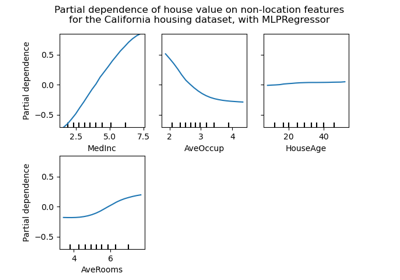sklearn.inspection.partial_dependence¶
-
sklearn.inspection.partial_dependence(estimator, X, features, *, response_method='auto', percentiles=(0.05, 0.95), grid_resolution=100, method='auto')[source]¶ Partial dependence of
features.Partial dependence of a feature (or a set of features) corresponds to the average response of an estimator for each possible value of the feature.
Read more in the User Guide.
Warning
For
GradientBoostingClassifierandGradientBoostingRegressor, the ‘recursion’ method (used by default) will not account for theinitpredictor of the boosting process. In practice, this will produce the same values as ‘brute’ up to a constant offset in the target response, provided thatinitis a constant estimator (which is the default). However, ifinitis not a constant estimator, the partial dependence values are incorrect for ‘recursion’ because the offset will be sample-dependent. It is preferable to use the ‘brute’ method. Note that this only applies toGradientBoostingClassifierandGradientBoostingRegressor, not toHistGradientBoostingClassifierandHistGradientBoostingRegressor.- Parameters
- estimatorBaseEstimator
A fitted estimator object implementing predict, predict_proba, or decision_function. Multioutput-multiclass classifiers are not supported.
- X{array-like or dataframe} of shape (n_samples, n_features)
Xis used to generate a grid of values for the targetfeatures(where the partial dependence will be evaluated), and also to generate values for the complement features when themethodis ‘brute’.- featuresarray-like of {int, str}
The feature (e.g.
[0]) or pair of interacting features (e.g.[(0, 1)]) for which the partial dependency should be computed.- response_method‘auto’, ‘predict_proba’ or ‘decision_function’, optional (default=’auto’)
Specifies whether to use predict_proba or decision_function as the target response. For regressors this parameter is ignored and the response is always the output of predict. By default, predict_proba is tried first and we revert to decision_function if it doesn’t exist. If
methodis ‘recursion’, the response is always the output of decision_function.- percentilestuple of float, optional (default=(0.05, 0.95))
The lower and upper percentile used to create the extreme values for the grid. Must be in [0, 1].
- grid_resolutionint, optional (default=100)
The number of equally spaced points on the grid, for each target feature.
- methodstr, optional (default=’auto’)
The method used to calculate the averaged predictions:
‘recursion’ is only supported for some tree-based estimators (namely
GradientBoostingClassifier,GradientBoostingRegressor,HistGradientBoostingClassifier,HistGradientBoostingRegressor,DecisionTreeRegressor,RandomForestRegressor, ) but is more efficient in terms of speed. With this method, the target response of a classifier is always the decision function, not the predicted probabilities.‘brute’ is supported for any estimator, but is more computationally intensive.
‘auto’: the ‘recursion’ is used for estimators that support it, and ‘brute’ is used otherwise.
Please see this note for differences between the ‘brute’ and ‘recursion’ method.
- Returns
- averaged_predictionsndarray, shape (n_outputs, len(values[0]), len(values[1]), …)
The predictions for all the points in the grid, averaged over all samples in X (or over the training data if
methodis ‘recursion’).n_outputscorresponds to the number of classes in a multi-class setting, or to the number of tasks for multi-output regression. For classical regression and binary classificationn_outputs==1.n_values_feature_jcorresponds to the sizevalues[j].- valuesseq of 1d ndarrays
The values with which the grid has been created. The generated grid is a cartesian product of the arrays in
values.len(values) == len(features). The size of each arrayvalues[j]is eithergrid_resolution, or the number of unique values inX[:, j], whichever is smaller.
See also
sklearn.inspection.plot_partial_dependencePlot partial dependence
Examples
>>> X = [[0, 0, 2], [1, 0, 0]] >>> y = [0, 1] >>> from sklearn.ensemble import GradientBoostingClassifier >>> gb = GradientBoostingClassifier(random_state=0).fit(X, y) >>> partial_dependence(gb, features=[0], X=X, percentiles=(0, 1), ... grid_resolution=2) # doctest: +SKIP (array([[-4.52..., 4.52...]]), [array([ 0., 1.])])

